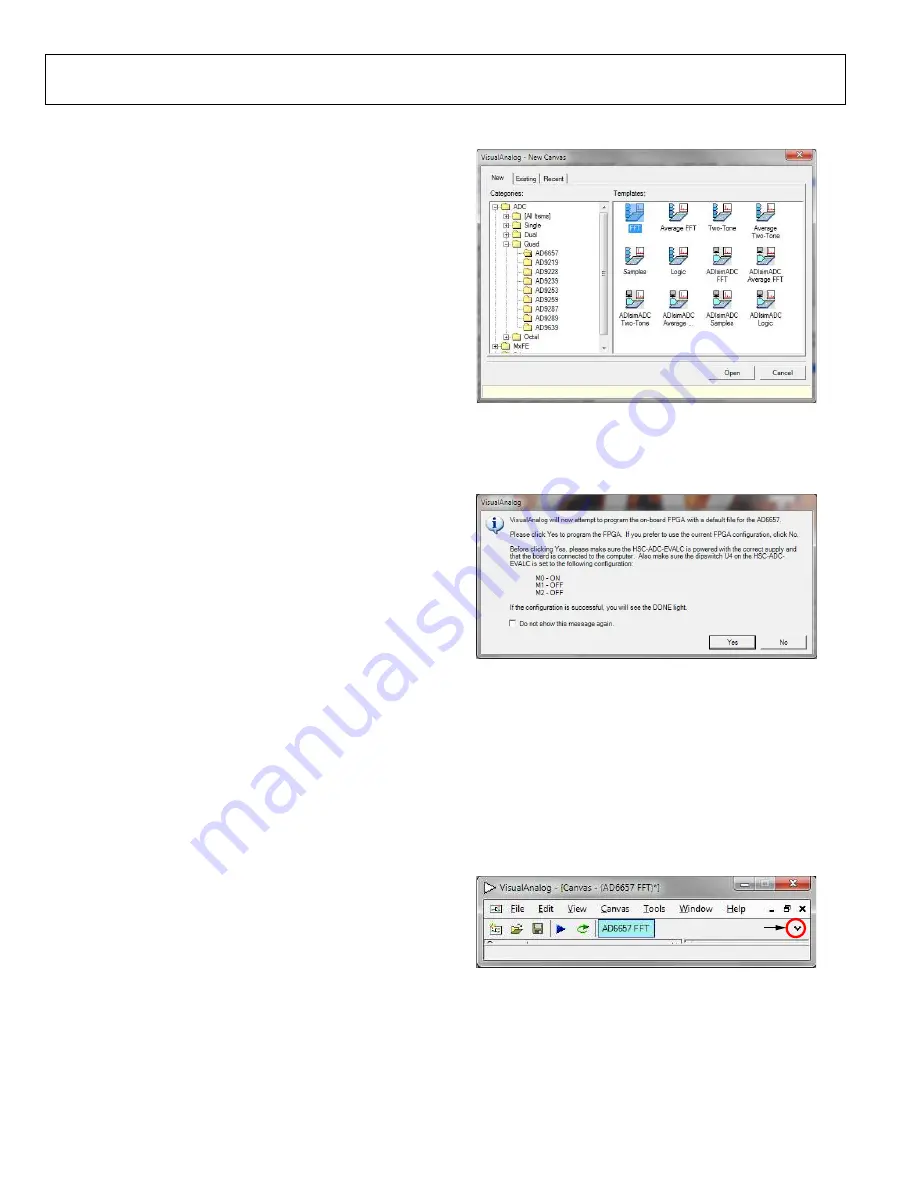
UG-232
Evaluation Board User Guide
Rev. 0 | Page 6 of 32
EVALUATION BOARD SOFTWARE QUICK START PROCEDURES
This section provides quick start procedures for using the
evaluation board. Both the default and
optional settings are described.
CONFIGURING THE BOARD
Before using the software for testing, configure the evaluation
board as follows:
1.
Connect the evaluation board to the data capture board, as
shown in Figure 1 and Figure 2.
2.
Connect one 6 V, 2.5 A switching power supply (such as
the CUI EPS060250UH-PHP-SZ supplied) to the AD6642/
AD6657
board.
3.
Connect one 6 V, 2.5 A switching power supply (such
as the CUI EPS060250UH-PHP-SZ supplied) to the
HSC-ADC-EVALCZ board.
4.
Connect the HSC-ADC-EVALCZ board (J6) to the PC
with a USB cable.
5.
On the ADC evaluation board, confirm that there are no
jumpers installed on any of the header pins.
6.
Connect a low jitter sample clock to the connector J702.
7.
When using the AD6642 version of the ADC evaluation
board, use a clean signal generator with low phase noise to
provide an input signal to the desired A and/or B channel(s).
If using the AD6657 version of the ADC evaluation board,
use a clean signal generator with low phase noise to provide
an input signal to the desired A, B, C, and/or D channel(s).
Use a 1 m, shielded, RG-58, 50 Ω coaxial cable to connect
the signal generator. For best results, use a narrow-band band-
pass filter with 50 Ω terminations and an appropriate center
frequency. (Analog Devices uses TTE, Allen Avionics, and
K&L band-pass filters.)
USING THE SOFTWARE FOR TESTING
Setting Up the ADC Data Capture
After configuring the board, set up ADC data capture using the
following steps:
1.
Open VisualAnalog on the connected PC. The appropriate
part type should be listed in the status bar of the
VisualAnalog – New Canvas
window. Select the template
that corresponds to the type of testing to be performed
(see Figure 4 where the AD6657 is shown as an example).
09
57
2-
00
4
Figure 4. VisualAnalog - New Canvas Window
2.
After the template is selected, a message appears asking if
the default configuration can be used to program the FPGA
(see Figure 5). Click
Yes
, and the window closes.
09
57
2-
0
05
Figure 5. VisualAnalog Default Configuration Message
3.
To change features to settings other than the default settings,
click the
Expand Display
button, located on the bottom
right corner of the window shown in Figure 6 to see what is
shown in Figure 7.
Detailed instructions for changing the features and capture
settings can be found in the
Application Note,
VisualAnalog Converter Evaluation Tool Version 1.0 User
Manual
. After the changes are made to the capture settings,
click
Collapse Display
(see Figure 7).
09
57
2-
00
6
EXPAND DISPLAY
Figure 6. VisualAnalog – [Canvas – (AD6657 FFT)*] Window Toolbar,
Collapsed Display
Содержание AD6642
Страница 13: ...UG 232 Evaluation Board User Guide Rev 0 Page 12 of 32 09572 021 Figure 21 Board Power Input and Supply...
Страница 18: ...Evaluation Board User Guide UG 232 Rev 0 Page 17 of 32 09572 026 Figure 26 Default Clock Input Circuit...
Страница 19: ...UG 232 Evaluation Board User Guide Rev 0 Page 18 of 32 09572 027 Figure 27 Optional Clock Input Circuit...
Страница 20: ...Evaluation Board User Guide UG 232 Rev 0 Page 19 of 32 09572 028 Figure 28 Optional AD9517 Clock Input Circuit...
Страница 21: ...UG 232 Evaluation Board User Guide Rev 0 Page 20 of 32 09572 029 Figure 29 SPI Configuration Circuit...
Страница 22: ...Evaluation Board User Guide UG 232 Rev 0 Page 21 of 32 09572 030 Figure 30 FIFO Board Connector Circuit...






















